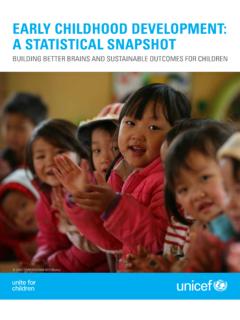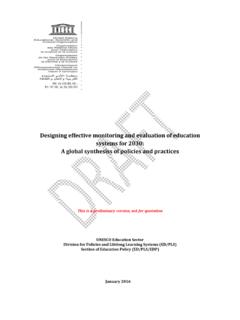Transcription of Child poverty in perspective: An overview of child …
1 For every Child Health, Education, Equality, Protection ADVANCE HUMANITYAn overview of Child well-being in rich countriesA comprehensive assessment of the lives and well-being of children and adolescents in the economically advanced nationsUNICEF Innocenti Research Centre report Card 7 Child poverty in perspective: This publication is the seventh in a series of Innocenti report Cards, designed to monitor and compare the performance of the OECD countries in securing the rights of their children. Any part of the Innocenti report Card may be freely reproduced using the following reference: UNICEF, Child poverty in perspective: An overview of Child well-being in rich countries, Innocenti report Card 7, 2007 UNICEF Innocenti Research Centre, Florence.
2 The United Nations Children s Fund, 2007 Full text and supporting documentation can be downloaded from the UNICEF Innocenti Research Centre support of the German Committee for UNICEF in the development of report Card 7 is gratefully acknowledged. Additional support was provided by the Swiss Committee for UNICEF Innocenti Research Centre in Florence, Italy, was established in 1988 to strengthen the research capability of the United Nations Children s Fund (UNICEF) and to support its advocacy for children worldwide. The Centre (formally known as the International Child Development Centre) generates research into current and future areas of UNICEF s work. Its prime objectives are to improve international understanding of issues relating to children s rights and to help facilitate the full implementation of the United Nations Convention on the Rights of the Child in both industrialized and developing countries.
3 The Centre s publications are contributions to a global debate on Child rights issues and include a wide range of opinions. For that reason, the Centre may produce publications that do not necessarily reflect UNICEF policies or approaches on some topics. The views expressed are those of the authors and do not necessarily reflect the policy or views of Innocenti Research Centre Piazza SS. Annunziata, 12 50122 Florence, Italy Tel: (+39) 055 20 330 Fax: (+39) 055 2033 220 Innocenti Research Centre The true measure of a nation s standing is how well it attends to its children their health and safety, their material security, their education and socialization, and their sense of being loved, valued, and included in the families and societies into which they are Card 7I N N O C E N T I RE P O R T CA R D 71 The chart below presents the findings of this report Card in summary form.
4 Countries are listed in order of their average rank for the six dimensions of Child well-being that have been A light blue background indicates a place in the top third of the table; mid-blue denotes the middle third and dark blue the bottom 1 Dimension 2 Dimension 3 Dimension 4 Dimension 5 Dimension 6 Dimensions of Child well-beingAverage ranking position (for all 6 dimensions)Material well-beingHealth and safetyEducational well-beingFamily and peer relationshipsBehaviours and risksSubjective United report Card provides a comprehensive assessment of the lives and well-being of children and young people in 21 nations of the industrialized world. Its purpose is to encourage monitoring, to permit comparison, and to stimulate the discussion and development of policies to improve children s lives.
5 The report represents a significant advance on previous titles in this series which have used income poverty as a proxy measure for overall Child well-being in the OECD countries. Specifically, it attempts to measure and compare Child well-being under six different headings or dimensions: material well-being, health and safety, education, peer and family relationships, behaviours and risks, and young people s own subjective sense of well-being. In all, it draws upon 40 separate indicators relevant to children s lives and children s rights (see pages 42 to 45).Although heavily dependent on the available data, this assessment is also guided by a concept of Child well-being that is in turn guided by the United Nations Convention on the Rights of the Child (See box page 40).
6 The implied C H Il D wE l l -B E I N G I N R I C H C oU N T R I E S: A S U M M A Ry T A Bl EoECD countries with insufficient data to be included in the overview : Australia, Iceland, Japan, luxembourg, Mexico, New Zealand, the Slovak Republic, South Korea, N N O C E N T I RE P O R T CA R D 7definition of Child well-being that permeates the report is one that will also correspond to the views and the experience of a wide public. Each chapter of the report begins by setting out as transparently as possible the methods by which these dimensions have been assessed. Main findings The Netherlands heads the table of overall Child well-being, ranking in the top 10 for all six dimensions of Child well-being covered by this report .
7 European countries dominate the top half of the overall league table, with Northern European countries claiming the top four places. All countries have weaknesses that need to be addressed and no country features in the top third of the rankings for all six dimensions of Child well-being (though the Netherlands and Sweden come close to doing so). The United Kingdom and the United States find themselves in the bottom third of the rankings for five of the six dimensions reviewed. No single dimension of well-being stands as a reliable proxy for Child well-being as a whole and several OECD countries find themselves with widely differing rankings for different dimensions of Child well-being. There is no obvious relationship between levels of Child well-being and GDP per capita.
8 The Czech Republic, for example, achieves a higher overall rank for Child well-being than several much wealthier countries including France, Austria, the United States and the United and policyWhat is to be gained by measuring and comparing Child well-being in different countries?The answer lies in the maxim to improve something, first measure it .Even the decision to measure helps set directions and priorities by demanding a degree of consensus on what is to be measured on what constitutes progress. Over the long-term, measurement serves as the handrail of policy, keeping efforts on track towards goals, encouraging sustained attention, giving early warning of failure or success, fuelling advocacy, sharpening accountability, and helping to allocate resources more effectively.
9 Internationally, measurement and comparison gives an indication of each country s strengths and weaknesses. It shows what is achievable in practice and provides both government and civil society with the information to argue for and work towards the fulfilment of children s rights and the improvement of their lives. Above all, such comparisons demonstrate that given levels of Child well-being are not inevitable but policy-susceptible; the wide differences in Child well-being seen throughout this report Card can therefore be interpreted as a broad and realistic guide to the potential for improvement in all OECD the potential value of this exercise, every attempt has been made to overcome data limitations. Nonetheless, it is acknowledged throughout that the available data may be less than ideal and that there are prominent gaps.
10 Children s exposure to violence in the home both as victims and as witnesses,2 for example, could not be included because of problems of cross-national definition and measurement. Children s mental health and emotional well-being may also be under-represented, though attempts have been made to reflect these difficult-to-measure dimensions (see, for example, the results of surveys into children s own perceptions of their own lives on pages 34 and 38). Age and gender differences are also insufficiently attended to, again reflecting a lack of disaggregated data and the fact that the majority of the available statistics relate to the lives of older children. A particularly important omission is the level of participation by three and four year-olds in early childhood education (for which, again, no internationally comparable data are available).












